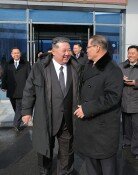The road to become a space power has opened
The road to become a space power has opened
Posted June. 22, 2022 07:57,
Updated June. 22, 2022 07:57
South Korea’s domestically produced Nuri rocket, launched at 4 p.m. local time on Tuesday at the Naro Space Center in Goheung, South Jeolla Province, successfully reached its target height in 16 minutes since takeoff. The “performance verification” satellite topped onto the Nuri rocket successfully separated at 700 kilometers and started to send signals to the ground control center. With successful takeoff of the Naro rocket, South Korea has begun its challenge of becoming a space power.
The Nuri rocket is a homegrown “K-rocket” produced entirely by using its own technology, from design, manufacture, launch to commissioning, in a span of 12 years since 2010. The rocket’s 75-ton engine and the launch pad were solely developed by the South Korean engineers. Back in the first launch conducted in October 2021, the third-stage rocket failed to place a dummy satellite onto the target orbit due to early exhaustion. Having successfully launched its indigenous rocket in the second attempt, South Korea has become the seventh country capable of launching more than 1-ton multi-purpose satellites, following Russia, the U.S., China, Japan, the E.U., and India. Given the success rate for newly developed rockets at the first attempt is only 30 percent, it is an outstanding feat for South Korea to succeed to place satellites onto an orbit in just two attempts with a rocket developed solely with its homegrown technology.
The country’s other space projects in the works include its first lunar orbiter, Danuri, using Space X’s launch vehicle, in forthcoming August, and launch a lunar lander onto a performance-improved homegrown rocket by 2030. South Korea, which used to be a least developed country, living in chronic hunger, when the Soviet Union sent an unmanned space mission to the Moon 63 years ago and the U.S. sent humans to the Moon 53 years ago, has grown into a country joining the global space race in earnest.
The country’s space industry is expected to grow even faster as successful experiences accumulate with the Nuri rocket launches planned four more times by 2027. South Korea will be able to fly communications, weather, and military satellites on its own, which it used to launch using other country’s technology, and even able to offer to launch satellites of other countries. Only in this year, some 700 microsatellites will be lifted off, twice as many than those launched last year. Being capable of developing launch vehicles with its own technology, South Korea’s status as a military power will be reinforced.
Still, it is a long way to go to become a true space power. Although the global space industry has grown to become far larger than the semiconductor industry, South Korea takes up less than 1 percent of the industry. Many advanced countries, including the U.S. and China, have entered a new phase of the Space Age, led by private entities and supported by the government. The success of the Nuri rocket launch is just the first step. The government should devise a mid to long term strategy to develop the space industry to become the country’s next growth engine.







